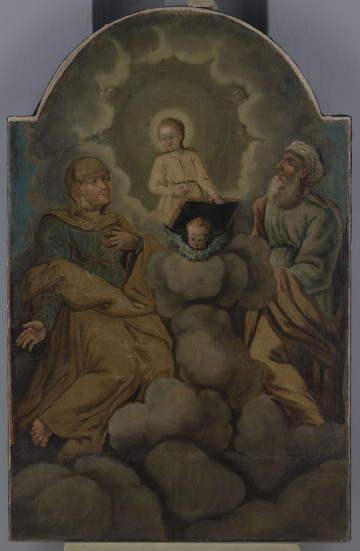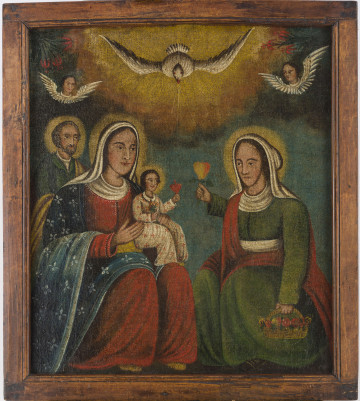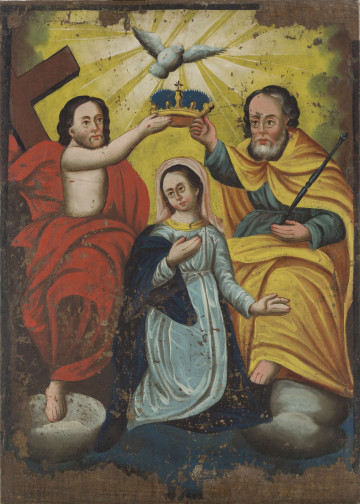
Saint Mary’s family
1801 — 1900
National Museum in Lublin
Part of the collection: Folk Art of the Lublin Region (17th–1st half of the 20th c.)
Painting workshops, working to meet the needs of rural consumers, prepared a wide range of paintings differing in price, purpose, and quality. They were painted on various bases, for example, on zinc or iron sheets in the 17th and 18th centuries. Paintings on such a surface were mainly intended for roadside shrines; most of them were created in the first half of the 19th century. Paintings on linden or poplar planks were more valued than sheet metal. They were made in guild workshops, mainly as copies of the Jasna Góra painting, and were intended for churches. A special group among them were the so-called decorated paintings, in which only the faces and hands were painted, while the parts of robes and the background were made of plastic mass using the decorative comb technique. However, the basic assortment of craft workshops – from Częstochowa, Lesser Poland or Silesia – were paintings on canvas. They were purchased for homes of all social classes and were intended to be placed in church banners or feretories. The oldest ones, painted on self-made linen canvas, date from the turn of the 18th and 19th centuries. Most of the surviving paintings were made on the factory linen that was used from the 1830s onwards.
The cheapest but also the least durable paintings were created on paper. At first, they were painted with varnish paints on cardboard made of cotton. In the second half of the 19th century tempera water paints started to be used with rye clay or gelatine sometimes added in order to increase the covering function. It was noticed that ‘the so-called water painting, or gouache painting, which does not belong to the guild [...] has taken a wrong direction, especially omitting the attention to the drawing – by abundant use of bright paints [...] light yellow and blue (ultramarine), previously almost unknown [...]. There are enough reasons for introducing this corrupted taste, among them counting on ignorance and allowing prices to be too low, for an elbow painting of this genre sells from eight to forty pennies, when the paper costs about five pennies. At this price goes an unheard of and hurried production'.
Author / creator
Dimensions
cały obiekt: height: 52,5 cm, width: 60,5 cm
Object type
picture
Technique
painting technique
Material
paper, tempera
Creation time / dating
Creation / finding place
Owner
The National Museum in Lublin
Identification number
Location / status

1801 — 1900
National Museum in Lublin

1845 — 1855
National Museum in Lublin

1801 — 1900
National Museum in Lublin
DISCOVER this TOPIC
National Museum in Lublin
DISCOVER this PATH
Educational path